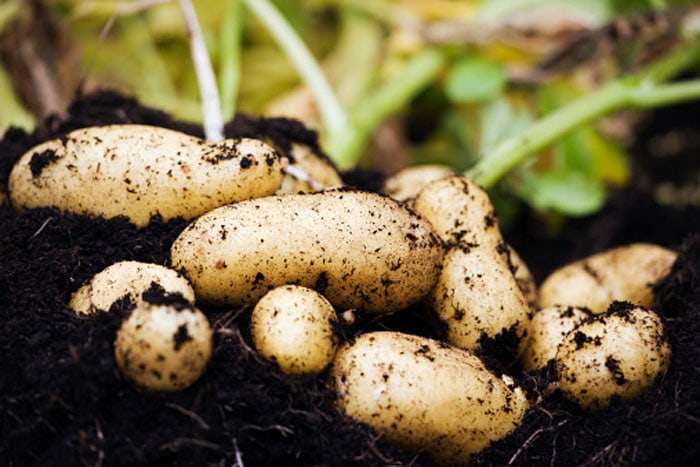
Written By: Christina Newberry
Reviewed By: Gloria Tsang, RD
Title: Registered Dietitian
Last Updated on:

Potatoes are a staple of the North American diet. Unfortunately, many of the potatoes we buy in grocery stores have been treated with chemicals to prevent them from sprouting.
The good news is that potatoes are very easy to grow at home – even if you don’t have a yard – and you can start with organic seed potatoes to ensure you’re getting the nutritional value the potato was meant to offer. Plus, once you’ve tasted fresh new potatoes steamed and tossed with a drizzle of olive oil and parsley or mint, you’ll be hooked.
Here’s how to grow your own non-GMO potatoes at home.

Potatoes are not grown from seeds. Instead, they are grown from “seed potatoes,” which are simply potatoes that have begun to sprout. You can buy seed potatoes at most garden shops, and there are many sources available online (search for “seed potatoes” plus your state or province to find a local source). Check the packaging of the seed potatoes, or ask the supplier, to ensure you are buying non-GMO spuds.
You might think you could just wait for a grocery store potato to sprout and pop it into the ground. Unfortunately, grocery store potatoes are unlikely ever to produce new potatoes, as they have been treated specifically to make this impossible. These treatments increase the shelf-life of potatoes in storage, preventing them from growing sprouts and going soft, but they mean that the potatoes are incapable of reproducing.
You can try planting organic potatoes purchased from a grocery store, but the results may not be what you are expecting. Potatoes are prone to several diseases that can build up from generation to generation. These are not issues that will make people sick, but they do impact the potatoes’ ability to reproduce. Seed potatoes are usually checked to make sure they do not carry any of these diseases that will impact your potato yield. Check with your supplier to ensure the seed potatoes you buy are “certified disease-free.”
If you have a yard with a veggie patch, you can plant your potatoes the traditional way – burying them in the soil and “hilling up” soil on top to create a small hill or mound where your potatoes will grow.
If you don’t have a yard, or if you just don’t want to take up a lot of space growing potatoes, you can grow them in a container on your balcony or porch. Here’s how it’s done:
Potatoes are surprisingly easy to grow and need very little attention other than some watering. They don’t need to take up much space, and the plants are even nice to look at. Plus, at the end of the season, you’ll end up with a delicious harvest of non-GMO potatoes. Just wait until you taste them!
Alumni: University of Victoria – Christina Newberry is a writer and editor whose work has appeared in national and local magazines and newspapers. With a Bachelor’s degree in English and Anthropology from the University of Victoria and a Journalism Certificate from Langara College, Christina brings keen curiosity and the love of a good story to her work with HealthCastle.com.
Christina is a passionate traveler and urban gardener with an interest in vegetarian eating and making good, tasty food from scratch. Sharing lessons learned from her own experiences, Christina writes about lifestyle topics for HealthCastle, with a focus on eating well at home and on the road.